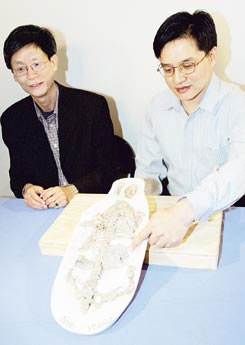Chinese farmers discovered the bones of two large mammals from the Mesozoic era. The remains of a small dinosaur were found in the stomach of one of them. Until now it was believed that the mammals of that time were mice that fed on insects
John Noble Wilford, New York Times, Haaretz, News and Walla!

The remains of the predatory mammal. A completely new picture of the animals in the age of the dinosaurs (Photo: AP)
Direct link to this page: https://www.hayadan.org.il/mammelseatsdino.html
In the age of the dinosaurs, the mammals were still submissive creatures that had not yet evolved and took over the earth. Until recently, scientists believed that most of them were nocturnal creatures as small as mice, that fed mainly on insects and hid in caves or under vegetation from the terrifying reptiles, the masters of the land. However, two 130-million-year-old fossils, discovered in 2003 in northern China, indicate that the accepted theory underestimates the value of the early mammals.
It turns out that some of these mammals were big and smart enough to prey on dinosaurs - at least the younger ones. The discovery of the fossils leads to a new and more diverse view of mammal life in the Mesozoic era, which began 280 million years ago and lasted until 65 million years ago.
In an article and interview published on Thursday in the journal "Nature", the Chinese researchers described their findings, which include the skull and most of the bones of "Raphnomamus gigantecus" - the largest mammal from the dinosaur era found to this day. According to the researchers' estimate, this mammal weighed about 14 kilograms and was about one meter long. According to the researchers, Giganticus has no descendants among the species living today, but there is a certain similarity between it and the Tasmanian marsupial.
The second fossil discovered at the same site in China is of a smaller mammal of the Rhapnomamus robustus type, which is almost 40 centimeters long. Examining the fossil led to an unexpected discovery about its last meal: the limbs, fingers and teeth of a small dinosaur were found in the mammal's stomach.
The two fossilized skeletons were discovered by two Chinese farmers in the fertile archaeological sites of Liaoning County, where many remains of dinosaurs and mammals have been uncovered in recent years.
The fossils caught the eye of the scientists who visited the site, and they passed them on for examination at the "Institute of Paleanthropology and Paleontology of Reptiles" in Beijing - where the fossil of the Giganticus is now displayed. The researchers are now working on making a full-size model of the mammal, in preparation for a new dinosaur exhibit at the "American Museum of Nature" in New York, which will open this May.
"Our discovery is the first direct evidence that some mammals were carnivores, feeding on small vertebrates - including young dinosaurs. They also show that the mammals of the Mesozoic period were much larger than what was known until now," the article states. The researchers concluded that "some mammals probably competed with dinosaurs for food and territory".
Dr. Jin Meng, a paleontologist from the American Museum of Nature in Manhattan, who was among the researchers who discovered the findings, said last week that any mammal fossil from the Mesozoic era is quite rare, and those found "give us a completely new picture of the animals in the age of the dinosaurs." According to him, "now we have to find out how common the species of the large predatory mammals were".
However, Dr. Meng continues to argue that the conventional wisdom regarding life in the Mesozoic era is still valid. According to him, even if fossils of other large mammals from this period are found, it is still very likely to assume that the vast majority of early mammals were much smaller than the dinosaurs and the other reptiles that ruled the earth - which were stronger, had a longer lifespan and were faster than the mammals. Only after the extinction of the dinosaurs, about 65 million years ago, did the mammals begin to establish themselves and begin the process of evolution from which the tigers, lions and bears, and finally humans also developed.
They knew the dinosaurs
https://www.hayadan.org.il/BuildaGate4/general2/data_card.php?Cat=~~~59671028~~~37&SiteName=hayadan
